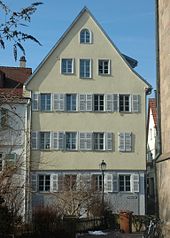Hölderlin-Gymnasium Lauffen am Neckar
| Hölderlin-Gymnasium Lauffen am Neckar | |
|---|---|
 View of the Hölderlin-Gymnasium from Reisweg (Feb. 2009) |
|
| type of school | high school |
| founding | 1491 |
| address |
Charlottenstrasse 87 |
| place | Lauffen am Neckar |
| country | Baden-Württemberg |
| Country | Germany |
| Coordinates | 49 ° 4 '14 " N , 9 ° 8' 22" E |
| carrier | state |
| student | 629 (as of 2019) |
| Teachers | 53 + 6 trainee lawyers |
| management | Mirja Koelzow |
| Website | www.hoegy-lauffen.de |
The Hölderlin-Gymnasium ( HöGy for short ) is a general education high school in Lauffen am Neckar . The school is named after Friedrich Hölderlin, who was born in Lauffen .
history
The grammar school can be traced back to the predicature established in 1491 by Count Eberhard im Bart from Württemberg . For the year 1506 a Martin Larin is attested as the first official schoolmaster , before the pastor had also taken over the office of the teacher. When the Reformation reached Württemberg in the middle of the 16th century, the predicature was incorporated into the Latin school founded by Duke Ulrich , whose task it was to train the offspring of Württemberg officials and theologians. By 1520 no fewer than 17 students had registered at the universities of Heidelberg and Tübingen , some of whom later served as pastors in Lauffen.
From 1835 onwards, several royal ministerial decrees were issued, according to which, in particular, single-class Latin schools were to be converted into secondary schools . In Lauffen, these decrees were implemented after the death of the Preceptor Christoph Jakob Klunzinger, who had worked at the school since 1812. The aim of this transformation was "partly to promote general civic education, partly to make it fit for the various bourgeois professions". The conversion met with protests from interested parents, and a group of 49 people expressed their opposition. After a minister himself had been involved, a compromise was first reached, which provided for a secondary school with Latin lessons. From 1838 onwards this compromise proposal was provided with a state grant of 200 guilders, but in the following years there were repeated quarrels and requests for redesign. From 1848 the school was again run as a Latin school.
During the First World War the school was run in two classes , during the Second World War it was already called the Oberschule and had four classes . In 1954 she went to the Hölderlin Progymnasium in the newly built Hölderlin School in Hölderlinstrasse. For the Progymnasium , the new elementary school in the Hölderlin School and the Herzog-Ulrich Elementary School, there was a joint teaching staff and a joint administration until the organizational separation from the Herzog-Ulrich Elementary School came in 1962. In 1967 the school was expanded into a full high school , and in 1970 the first class passed their Abitur . In 1975 the Hölderlin-Gymnasium finally moved to a newly built building complex in the new school center in Weststadt.
building
The building of the old Latin school at Kirchbergstrasse 11 next to the rectory of the Regiswindiskirche was first mentioned during the visitation in 1547. Although located in the village, the house fell to the city of Lauffen. In its current form, the plastered half-timbered house dates from around 1700. It has a round arched cellar and corner blocks. The building was renovated in 1983.
In 1954 the new building was erected on Hölderlinstrasse in Lauffen, and in 1975/76 the company moved to Charlottenstrasse.
Well-known former students
- Johann Christoph von Herdegen (* 1787 in Lauffen am Neckar; † 1861), civil servant, politician and finance minister of the Kingdom of Württemberg
- Ernst Trumpp (* 1828 in Ilsfeld; † 1885), linguist
- Karl von Muff (* 1846 in Reutlingen; † 1935), Württemberg lieutenant general
- Robert Vollmöller (* 1849 in Ilsfeld; † 1911), Councilor of Commerce
- Eugen Klöpfer (* 1886 in Talheim; † 1950), actor
- Petra Schwille (* 1968 in Sindelfingen), physicist
Profiles
The Hölderlin-Gymnasium is a G8- Gymnasium that takes students eight years to the Abitur . The first foreign language from grade 5 onwards is English for all students. In the scientific profile with two foreign languages, either French or Latin follows from grade 6 and from grade 8 the profile subject natural sciences and technology . In the linguistic profile with three foreign languages, English follows Latin or French from grade 6 and Spanish from grade 8.
literature
- Otfried Kies: Festschrift 500 years of Latin school and Hölderlin-Gymnasium Lauffen am Neckar. To celebrate the 500th birthday on June 21, 1991 . 2nd Edition. Walter, Brackenheim-Hausen 1991 (with contributions by Kurt Eißele and Albert Gänßle).
- Basic description of the Latin School Lauffen a. N. (State Archives Ludwigsburg, signature E 202 Bü 190; created around 1850, with additions until 1919).
- Jürgen Reiner, Ulrich Böhner: Chronology of the school history of Lauffen . In: Lauffener Heimatblätter . Booklet 23. Heimatverein Gesellschaft Alt-Lauffen, Lauffen a. N. 2008.
Individual evidence
- ↑ a b c Otfried Kies: The Merowingerburg in the village - nucleus of Lauffen . In: Home book of the city of Lauffen am Neckar on the occasion of the big city festival in 1984 . City of Lauffen am Neckar, Lauffen am Neckar 1984, p. 103-118 .
- ^ Staatsarchiv Ludwigsburg E 202 Bü 1489 Bl. 13, quoted from The desired conversion of Württemberg Latin schools into Realschulen from 1835 to 1848 ( online in the Google book search).
- ↑ Tanja Blattner: The desired conversion of Württemberg Latin schools into secondary schools from 1835 to 1848. V and R Unipress, Göttingen 2006, ISBN 3-89971-277-3 , p. 181.
- ↑ City Lauffen at pro-region.de
